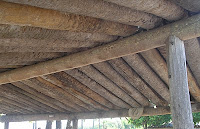Family: Arecaceae
Sub family:Ccoryphoideae
Tribe: Corypheae
Subtribe: Livistoninae
Genus: Copernicia
Species: Copernicia Alba Morong, Ann. New York Acad. Sci. 7: 246 (1893)
Heterotypic synonym ( Royal Botanic Garden, Kew, UK)
Copernicia nigra Morong, Ann. New York Acad. Sci. 7: 245 (1893).
Copernicia rubra Morong, Ann. New York Acad. Sci. 7: 247 (1893).
Copernicia australis Becc., Webbia 2: 158 (1908).
Coryphomia tectorum Rojas, Bull. Acad. Int. Géogr. Bot. 28: 158 (1918).
Copernicia ramulosa Burret, Notizbl. Bot. Gart. Berlin-Dahlem 10: 403 (1928).
Common name
Carandaa, Carandaí, Caranday, palma negra, palma blanca, palma espinillo, Queic
and many other epithets, according to the language of the ethnic group in every region of Gran Chaco
Geographical distribution:
Copernicia alba grows naturally in a wide open area of South America, covering territories in Northern of Beni Department in Bolivia, central west in this country, West Matogrosso in Brazil, central and northwestern Paraguay, northern and northeastern Argentina, where the provinces of Santa Fe and Corrientes is the southern limit of the species habitat at 30° South approximately. The region shown covers about 400,000 km2 where it is estimated that C. alba far outweigh the 500 million specimens (Markley 1955)
In Argentina, the growth area of Copernicia alba is located in the floodplains of big rivers (Paraná, Paraguay and Bermejo), a large plateau that ranges from 50 to 100 m above sea level in areas mostly grassland and savannah seasonally flooded with runoff from W-NW to E-SE, along the edges of forests occupied by high ridges, forming clusters of high concentration of individuals at different stages of development, more or less mono-specific called “palmares”.
In such areas, the absolute temperatures can exceed 42 ºC in summer and minimum down to -5 ºC in July with an annual average of 22 ºC. Have a record rainfall that varies with longitude, being the order of 1500 mm in the east and decreasing to 750 in the West.

The rains occur in the warm season, and are concentrated during the months of October to April. The minimum rainfall recorded during the winter, between June and August, which are drought and some frost. (National Weather Service)
The phenomenon of “El Niño”; has produced heavy rains that caused extraordinary flooding in much of the territory. Also, but less frequently, there are years that intensified and prolonged winter drought, which favors the occurrence of fires, natural and man-caused, in grassland and savannah.
Typically these groups of palms are associated with thorny vegetation of trees and shrubs in livestock farming regions for which, since immemorial time, it burns the grass in early summer for renovation of pastures.
Habitat
It then describes the study area the next job is comprised of the North and Northeast region of Argentina that within the Gran Chaco geographic region, corresponds to the so-called “Chaco Oriental” or Humid Chaco, which occupies roughly the eastern half of the provinces of Chaco and Formosa, starting from the northern half of the province of Santa Fe.
In the “Chaco Oriental” is a close link between different forms of landscape and vegetation that grows on them. The plant communities are conditioned by the topographic gradient occupied, and this is related, in turn, with the gradient of flooding. (Morello and Adámoli, 1967.1968 and 1974)
The “Monte Fuerte” (Strong Forest) or “Quebrachal” is the most important floristic community. In this forest dominated by species: Schinopsis balansae (Quebracho Colorado – red quebracho), Aspidosperma quebracho-blanco (Quebracho Blanco - white Quebracho); Caesalpinia paraguarienses (Guayacan); Prosopis nigra (black Algarrobo) Prosopis alba (white Algarrobo); Ziziphus mistol (Mistol); Geoffroea decorticans (Chañar) among many other species.
This is generally a semi-xeric forest with deciduous trees, which is in the high and intermediate terrain.
In highlands, sandy soils to moist but rarely waterlogged pastures are developed. In this soils grow many herbaceous species, including grasses such as Andropogon lateralis (paja colorada); Schizachiryum spicatum (foxtail) and Elionurus muticus (sweet-grass).
These high fields and grassland, tend to suffer fires, after which there are species that bloom immediately, as Calea cymosa, Turnera grandifolia, Aspalia pascaloides, etc.
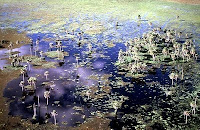

In the savannah area is covered by a carpet of herbaceous species, woody species apart, so it acquires a more open face, among woody plants include: Prosopis affinis (Ñandubay or Espinillo); Astronium balansae (Urunday) and Diplokeleba floribunda (Palo piedra).
The “Palmares” of Copernicia alba (Palma Blanca or Carandaí palm) grow in places almost pure, with an open canopy and a dense herbaceous carpet surface in alkaline and saline soils.
Many times, between the “Monte Fuerte”, the savannahs and the “Palmares”, there is a transition zones where has a lower open forest, with the coexistence of small-sized trees, palms and shrubs.
In the more developed mound, extend to form a narrow strip of gallery forest. These lands have a high positive relief and allow the installation of woody species can not thrive in flooded areas.
Among the tallest trees (more than 15 m)) include: Enterolobium contortisiliquum ( red timbo ) Tabebuia heptaphylla (pink flower Lapacho); Patagonula Americana (Guayaibi); Gleditsia amorphoides (Thorn Crown); Ocotea diospyrifolia (white laurel ) and Phytolocca dioica (ombu), Pisonia zapallo (Francisco Alvarez); Astronium balansae (Urunday), Capparis flexuosa (Guaycuru bean) and Brunfelsia uniflora (lily of the forest).
Often present the Arecaceae Syagrus romanzoffiana (Pindo) and Acrocomia aculeata (Mbocaya). Also abound many climbers and epiphytes.
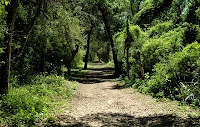

In the lower ground, clay soil, aquatic environments are represented by streams, gullies and lagoons where the soil remains covered with water from nine to eleven months per year and prevents the development of trees.
In these areas can be found: Sorghastrum setosum (yellow straw), Paspalum intermedium (silly straw); Panicum prioniti (roofing straw); Cyperus giganteus, (Piri), Schoenoplectus californicus (rush), and Thalia geniculata ( Pehuajo). (Morello and Adámoli, 1967.1968 and 1974)
This species is the coldest hardy of the genus Copernicia, coming to withstand low temperatures from -5 to -7 ° C without any damage
C. alba is not threatened despite the fact that farmers and ranchers burning and deforesting of their habitat to agricultural use, livestock or felling of trees for wood.
After the fires, palms lose their dead leaves and the remains of leaf sheaths and stems are smooth but the plant does not die. In some cases (quite common) the bud is damaged, and the palm branches. It has been found cases of dichotomous branching without apparent apical damage.


The burning of the “palmar” is also used as a management tool in livestock production, since shortly after the fire, the cause regrowth of the herbaceous layer, the nutritive value and the concentration of nitrogen and crude protein reach peak levels.
While the fire did not damage the adult palms remain standing, the seedlings are mortally wounded by the “palmar” lose continuity in their regeneration.
Description
Copernicia alba has solitary trunk, gray, slender, 7-9 m high and 0.25 m in diameter and can reach exceptionally to 13 m high and 0.40 m in diameter at the base. Is covered with leaf debris from the base to the first third of its height and continued smooth and naked to the crown of leaves. The crown is circular at the bottom keeping the dead leaves and debris infructescenses. Can have more than 50 leaves (Moraes 1991)
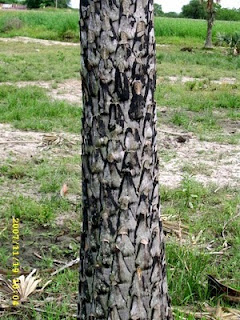
The leaves are clearly palmates, glaucous green, lamina 75-80 cm in diameter with 30-35 segments induplicates, slightly forked, each 35 cm long and 4-5 cm wide. The sinus can penetrate up to 75-80% of limbo. Hastula small, slightly acuminate adaxially.
The inflorescences are multiple, interfoliar and erect, standing out from the leaf crown. Long spadices with hermaphrodite flowers, pale cream-colored, solitary or grouped. Sepals 3, petals 3, stamens 6, monadelphous, coupled in turn with the corolla. Superior ovary composed of 3 free carpels at the base, once-ovulated. (Parodi, Dimitri 1987)

Flowering and fruiting
Copernicia alba blooms twice during the season. The first is from mid August to late October and the second begins in late February.
In the first bloom, abundant and prolific, there are pale yellow inflorescences, up to 1.8 m (2.3 m) interfoliar, upright, fixing an angle between 30 º and 45 º with the axis of the stipe.
In the second, flourish the old specimens, which not blossomed with the rest of the palm at the start of the season. Their inflorescences are few, small in size and vigor, not exceeding 1.20 m in length.
The formation of the fruit begins in early October, when some individuals are still flourishing, generating a superposition of infructescenses and inflorescences which facilitates pollination due to the visit of various insects.
Immature fruits, green in color, oval and covered by a yellow-white tomentum are visited by wasps that parasitize dipteran laying eggs in them and cause damage. The maturation continued until early May where the fruit has the final size of about 1.3 cm in diameter, the color changes to dark green and fruit becomes shiny, spherical, plump and smooth, losing the youthful tomentum.

It is common to find a number (variable depending on season) of fruits brown or black very weakly attached to rachillas making it unfeasible as they tend to fall from the palm and are parasitized by larvae that attack the seed endosperm.

The same specimens, identified, were reviewed again in late January and was verified a drastic loss of fruits during ripening. Count was repeated with the same method yielded an average of 519 ripe fruits per inflorescence with an average weight of 1.45 gr. per fruit, resulting in an amount of 519 x 22 = 11,482 individual mature fruits with a total mass of 16.649 kg
During the study period we observed a considerable amount of fruit damaged by oviposition of an unidentified species of Diptera. This damage was estimated to produce about 15% of loss in fruits, preventing the proper development of the seed. This correction factor of 11,482 indicates that average fruit of an adult, only 9,760 fruits per year would come to have a viable seed for the propagation of the species.

It was verified that the burning of pastures dramatically affect the production of fruits, due to overheating.
Pollinators and dispersers
The presence of wasps and honey bees notes anthesis of blooms and reveal the action of these pollinators.
It is remarkable participation of the Parrots (Monk parrots, Argentine parrots, Myiopsitta monachus) than to live and build their community nests in the palm work with pollination and dispersal.
Other important dispersers are the “Ñandues” (Rhea americana) which feed on the fruits of palm trees hanging low, giving grotesque, although high, jumping to reach them.
Once fallen, the cattle scattered the seeds as it is fed with fruits scattered at the foot of the palms and then regurgitate or defecate in their march towards the roosts. Is also won acting as a predator of the species to trampling and eating the leaves of young specimens.
Natural regeneration of the “Palmares”
From the simple observation of the species in its natural environment can reach the following conclusions:
- It is clear that a species that produces copious amounts of seeds useful, as we had (9,760 per year per individual), it does as a strategy for preservation of the species to predators, poor soil, inclement weather (drought and flood) and natural seasonal fires and possibly by lack of appropriate conditions for germination in nature.
- The fact that it is often the observation of palms growing in tight groups of 5-8 individuals of different ages and stages of development, we would indicate that despite the volume of seeds that fall from mother palms germinate only a few. Whether the activity of livestock, soil strength, lack of moisture or water drag at times of flooding.
- Also seen in the “palmares”, some specific areas where the seeds are washed away and perhaps where the soil moisture is favorable for germination, because it shows clearly a large agglomeration of young plants.
- Contrary to the above, it is not uncommon to see young plants in permanently flooded areas or long term. Some adults can only be seen growing in upland
- Clearly, fire plays a role in cleaning and selection of individuals. On the one hand burning the marcescent and leaves remains on the stems and soil that prevent contact of the seeds with ground and, by other, cause significant damage in seedlings and juveniles that rarely survive these fires


- Meanwhile, the floods also have its effect on the “palmar”. Disperse seeds to better locations. Germination occur as rainfall occurs during the warm season and allow the advancement of young roots in the mud, but also undermine the ground causing landslides and fall of adult palms, as it is easy to see inside of palmar.
- Livestock, dispersing seeds, also buried with their trampling preventing germination and feeds on the tender leaves of young palms in times of scarcity of pasture, destroying the apical shoots.
- However, a personal opinion, none of the above factors or human action, currently put at risk to this species. Fortunately.
Propagation, growing and transplanting
Like all palms, Copernicia alba were grown from seeds that germinate in about 30-45 days if the harvest is ripe. To hasten germination, are advised to remove the exocarp and mesocarp and clean seeds soaking in water at normal temperature for 5-7 days. Sow in peat or sand in seedbeds of not less than 10 cm deep. The recommended temperature is between 30 º C and 35 º C


Transplanting into individual container when the aerophilic emerges. This task should be performed carefully because it is very vulnerable to disruptions in their roots and is common the loss of newly transplanted specimens
In crops is advisable to grow in pots as when planting in the soil the palm develops a large, very sensitive, root system that does not tolerate unrest transplantation.
Like many species of the genus Sabal (Broschat and Donselman 1984 ª / b), C. alba must completely rebuild their root system when is extracted to the field for packaging or change of place.
It is therefore recommended, cut their roots in stages, passing just over a month between cuts to allow time for root system regeneration. Before extraction, making severe pruning of the crown of leaves.

It should be noted that individuals newly extracted and packaged, they should be resting in the shade, throughout the time until they begin to sprout again.
Uses

In Argentina, the logs are used primarily for farm buildings, fence posts, drinking fountains, tile roofing, corrals and shackles, poles for power lines and phones. With the leaves are woven baskets, hats, lampshades and hand-fans. (Ragonese and Covas 1942)
The extensive time of the blooms is used by honey producers to obtain high quality single-flower honeys and purity, which place their hives in the palm area
Studies conducted in the Province of Formosa indicate that at least 45% of honey samples collected contain Copernicia alba pollen and 5% of honey are mixed C. alba (43%) and Sagittaria montevidensis (29%). (Cabrera 2006). At the same time, (Salgado 2006), determines the existence of single-flower honeys of Copernicia alba in the Province of Chaco.






Using the C. alba trunks to rural buildings in Argentina
Also plant pots are made with Carandai palm trunks for both domestic market and for export to Europe.


On the other hand, in Paraguay using C. alba for the construction of rural furniture, for the manufacture of handicrafts like hats, bags, purses, fans and lampshades
In Bolivia, reported the use of trunks of C. alba for fence posts, telephone, electricity and rural construction. (Moraes 1991)
Use as ornamental
The difficulties of this specie in the adult transplant severely restricts its use as an ornamental.
However, resistance to cold, drought, floods and poor soils, makes a palm Copernicia alba ideal for those locations of climates and growing conditions difficult and justify the efforts to cultivate and transplant.
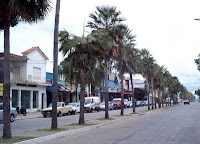
Notwithstanding the foregoing, the trunk without thorns, crown spherical very ornamental and orderly, glaucous coloring, the absence of large fronds hanging dry and comparatively small leaves make C. alba a kind suitable for both alignments, groups or isolated individuals, being widely used in the design of parks and gardens and in villages, shopping avenues, roundabouts and flower beds in general.
Geographical location of “palmares”
For anyone with concerns to meet and visit a “palmar” of Copernicia alba in Argentina, you can do in the areas adjacent to Route 16 in the vicinity of the General Belgrano interprovincial bridge connecting the provinces of Chaco and Corrientes. Latitude 27º 27 ‘South and Longitude 58º 55’ West
You can also visit the “Chaco National Park”, near the town of Colonia Elisa, protected natural area of Argentina created in 1954 to preserve the forests of Quebracho located in the eastern part of the province of Chaco. Latitude 26º 49’ South and Longitude 59º 39’ West


In full development of forestry and the purpose of removing an area to its progress, Chaco National Park, contains samples of all environments characteristic of the eastern Chaco district. The center, east and south park are covered by forests, resulting magnificent examples of “Quebracho Colorado” (Schinopsis balansae) that in some places almost pure form communities. The western part forms a typical savanna ecosystem with Carandaí palm (Copernicia alba), while the lagoon “Panza de Cabra” in the southeast, reduced in large part, the dry months and shows an intricate aquatic vegetation. (Microsoft Encarta 2009)Another palmar worth visiting is the “Pilcomayo River National Park”, nature reserve of Argentina, located in the northeastern province of Formosa, near the border with Paraguay. Created in 1951, lies on the south bank of the Pilcomayo River. In 1992 he was included in the List of Wetlands of International Importance Ramsar Convention. Latitude 25º 10’ South and Longitude 59º 39’ West


The park was created to protect streams, grasslands, lakes and dense gallery forests, which grow on the coast of the Pilcomayo River. The area has a warm climate with an annual temperature averaging between 22 and 24 º C, and an average annual rainfall of 1,200 mm. Regarding the flora, the “palmares” of Carandaí palm (Copernicia alba) occupy a large area of the park. Also include the following plant species: Quebracho colorado (Schinopsis balansae), Quebracho blanco (Aspidosperma quebracho-blanco); Urunday (Astronium balansae), Guayacan (Caesalpinia paraguariense) white Algarrobo (Prosopis alba), black Algarrobo (Prosopis nigra) Lapacho (Tabebuia heptaphylla) Ibirá pitá (Peltophorum dubium) and Cardon (Trichocereus terscheckii), among others. (Microsoft Encarta 2009)

Bibliography
* Morello, J. y J. Adámoli, “Vegetación y ambiente del nordeste del Chaco argentino”, Boletín Nº3, IX Jornadas Botánicas Argentinas, EEA Colonia Benítez, 1967.* Morello, J. y Adámoli, J., “Las grandes unidades de vegetación y ambiente del Chaco argentino”, Primera parte: Objetivos y metodología, Serie fitogeográficaNº10, Buenos Aires, INTA, 1968, 125 pp.
* Morello, J. y J. Adámoli, “Las grandes unidades de vegetación y ambiente del Chaco argentino”, Segunda parte: Vegetación y ambiente de la Provincia del Chaco, Serie fitogeográfica Nº13, Buenos Aires, INTA, 1974, 130 pp.
* Markley , K. S 1955 “Caranday A source of palm wax”. Principes 9: pp 39-52
* Moraes Monica R. 1991 “Contribucion al ciclo biologico de la palma Copernicia alba en un area ganadera “ (Espiritu, Beni, Bolivia). Ecologia en Bolivia Nro 18 pp 1-20
* Ragonese A. E. y Covas G. 1942 “Flora de la Provincia de Santa Fe – Las Palmeras” Darwiniana, t.4 (2-3) pp.285-302
* Cabrera Mirta M. 2006 “Caracterización polínica de las mieles de la Provincia de Formosa – Argentina” Rev. Mus. Argentino Cienc. Nat. n.s. 8(2) pp 135-142
*Salgado C. 2006. “Flora melífera en la Provincia del Chaco” Editor PROSAP Impreso por Ministerio de la Producción, Provincia del Chaco.
* Ortiz Rafael. “Recursos forestales y cambio en el uso de la tierra –Paraguay
” FAO. INFORMACION Y ANALISIS PARA EL MANEJO FORESTAL SOSTENIBLEINTEGRANDO ESFUERZOS NACIONALES E INTERNACIONALES EN 13PAISES TROPICALES EN AMERICA LATINA (GCP/RLA/133/EC)
* Broschat, T. K. and H. M. Donselman. 1984a. "Root regeneration in transplanted palms." Principes 28: 90-91.
* Broschat, T.K. and H.M. Donselman. 1984b. "Regrowth of severed palm roots." J. Arboric. 10: 238-240
*Parodi Lorenzo R. – Dimitri, Milan J. 1987 “Enciclopedia Argentina de Agricultura y Jardineria” Tomo I p 187. Tercera edición
* Microsoft ® Encarta ® 2009. © 1993-2008 Microsoft Corporation.
